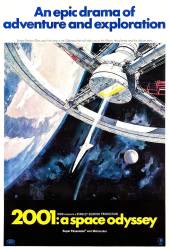Revealing mistake: When Dave Bowman attempts to re-enter Discovery One via the emergency airlock after blowing the explosive bolts on the pod door, where does said pod door go? And also, because of Newton's law of motion, the sudden rush of cabin air during decompression inside said pod after the bolts had blown the door off would have resulted in the pod being pushed in the opposite direction (in effect, that rapid escaping air would have acted like a rocket motor, propelling the pod like a cannonball from a gun!).
Suggested correction: Did you watch the film? The pod bay door doesn't come into it. Bowman enters via the emergency entrance, not a pod bay. The door of the pod and the door of the emergency exit slide sideways into cavities that are there for that purpose - hinged doors don't make any sense in a cramped spacecraft. We see the emergency entrance doorway slide back into position when Bowman activates it.
I think you confused the pod bay door with the door on the pod itself. In the explosive bolt sequence, the pod door does disappear. There is an expanding cloud from the pod door, but no flying door or evidence of it in the emergency airlock. Just an open hole in the pod.
In the scene just before HAL reads the astronauts' lips in the pod, we see that the pod door does slide sideways into the pod hull. The explosive bolts, marked by small red patches, are located in a pattern all around the edge of the door. This indicates that the explosive bolts would blow that section of the door outward rather than sideways into the hull storage pocket.
Bowman programmes the bolts on one side of the door only to detonate, blowing it sideways.
Sure, that might work, but how about this? Bowman knows that the door is constructed of a special composite material that instantly vaporises if it is compressed in just the right way. So, he reprograms the charges to set up a harmonic series of shock wave fronts that destabilises the composite of the door structure, tuning it into the large cloud of smoke we see in the scene.
Continuity mistake: When we see the outside of the cave where the apes are sleeping for the first time it's at sunset. We can see the sun and cloud behind the cave as if it is just sitting in a rock face with nothing behind it, but in the next shot when it's daytime suddenly there is a background of rocks and mountains behind the cave.
Deliberate mistake: On the space station after Dr. Floyd has just gotten off the elevator and is talking to a receptionist, the moon image in the window is revolving with the exact appearance it had when Floyd was in the telephone booth when the camera angle is perpendicular to the window and presumably parallel to the station's rotational axis. In the receptionist scene, the view of the window is at an angle yet the rotating moon image is the same. This would require a different axis of rotation for the space staton - one in which the station would be wobbling.
Revealing mistake: When Dr. Floyd arrives at the Moon and goes to the Monolith site at Tycho Crater, the moon shuttle never casts a shadow on the lunar surface. This is especially noticeable in the first shot, wherein the shuttle is coming straight at the camera, the Sun is on the far right, and there is a giant lunar cliff on the far left. No shadow of any sort.
Factual error: In the title shot, the camera rises above the dark side of the moon, revealing the crescent of the Earth, which in turn reveals the full disc of the Sun. The Sun is surrounded by the pinpoint lights of distant stars, but there are virtually no stars visible on the darkened far left and far right sides of the screen. This is exactly opposite of how real-life astronauts describe the star scape: Astronauts say that no stars are visible when looking in the general direction of the Sun, and that stars only become visible to the human eye as you turn away from the Sun.
Continuity mistake: In the scene where HAL is reading the lips of Bowman and Poole through a pod window, while they are in the pod discussing his possible disconnection, they are shown to be directly facing each other, keeping their heads perfectly still, while HAL looks back and forth from mouth to mouth. In the previous scene, the two men were not conversing in this unusual manner.
Visible crew/equipment: In both EVA scenes, first when Dave retrieves the AE-35 Unit, and when Frank goes to re-install it, there are shots of Discovery in the background, the pod in the foreground and the astronaut floating between. And in both of these shots, the pod rotates 180 degrees. In the front window of the pod, we can see reflected images of the film set and equipment as the pod rotates.





